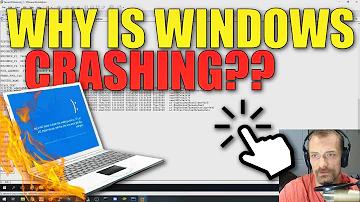Was sind Win Dump Files?
What is a win dump file?
A dump file is a snapshot that shows the process that was executing and modules that were loaded for an app at a point in time. A dump with heap information also includes a snapshot of the app's memory at that point.

Should I delete win dump files?
Well, deleting the files will not affect the normal use of your computer. So it is safe to delete system error memory dump files. By deleting system error memory dump files, you can get some free space on your system disk. However, dump files can be recreated automatically every time when there is a system crash.
Can you delete win dump files?
To delete the error dump files with Command Prompt, use these steps: Open Start. Search for Command Prompt, right-click the top result, and select the Run as administrator option. Type the following command to delete the system error memory dump files and press Enter: del /f /s /q %systemroot%memory.
Is it OK to delete crash dump files?
Yes, it is definitely safe to delete Memory. dmp file. It is only used to identify the cause of system crashes so If the system crash was already fixed or the system is already stable then you don't have any use for this dmp file. I hope this helps.
Can I delete Ramdump files?
You can safely delete the logs.
Where is Windows dump file?
C:WindowsMinidump
Your dump file is named C:WindowsMinidumpMinidump.
What files should I not delete?
To prevent any miserable data loss in your Windows computer, avoid deleting these seven windows files and folders.
- Program files folder. …
- WinSxS folder. …
- System32 folder. …
- Windows folder. …
- System volume information folder. …
- Swapfile. …
- Pagefile.
What folders should I not delete from Windows 10?
7 Files and Folders You Should Never Delete on Windows
- “Program Files” Folder. …
- “Windows” Folder. …
- “System32” Folder. …
- “WinSxS” Folder. …
- “System Volume Information” Folder. …
- “Pagefile. …
- “Swapfile. …
- Author Introduction:
Where are win dump files stored?
C:WindowsMinidumpMinidump
Your dump file is named C:WindowsMinidumpMinidump.
Should I delete system memory dump files?
Is it Safe to Delete System Error Memory Dump Files? If you are running out of space in your C drive or the system becomes slow, then you can delete these system error memory dump files. It is safe to delete system error memory dump files.
What causes dump files?
What are they? As the name suggests, dump files contain the information “dumped” from a program's memory when it crashes. That means you get information such as the processes that were running at the time of the crash, date and time stamp, associated programs and drivers, and more.
Where are Windows dump files?
Your dump file is named C:WindowsMinidumpMinidump.
How do I open a .DMP file in Windows?
Click the File menu. Click Start debugging. Click Open Dump file. Select the Dump file from the folder location – for example, %SystemRoot%Minidump.
What is the most important file in Windows?
The most important and irreplaceable files on your computer are your personal files. The windows system files etc. can be reinstalled, but your applications and your data are the most important files on your computer which have to be backed up periodically according to the changes and need.
Are permanently deleted files gone forever?
But apparently, permanently deleting all your files and other important data even in the Recycle Bin is not enough. It is not technically "deleted." Although the operating system can't find it anymore, a copy of it is still accessible through your hard drive.
What files can I delete in C drive?
Location: C:WindowsTemp
The files and folders inside contain info that Windows used at one time, but doesn't need anymore. Instead of cleaning via Disk Cleanup. you can visit this folder and delete its contents manually, if you want. Just press Ctrl + A to select everything inside, then hit Delete.
Where are all useless files in Windows 10?
- Select Start > Settings > System > Storage > Cleanup recommendations. Open Storage settings.
- Select the temporary files, unused files, files synced to the cloud, or unused apps you want to remove, then select the Clean up button for each section.
How do I view Windows dump files?
Follow these steps to open and analyze a Dump file in Windows 10:
- Click Search in the Taskbar and type WinDbg,
- Right-click WinDbg and select Run as administrator.
- Click the File menu.
- Click Start debugging.
- Click Open Dump file.
- Select the Dump file from the folder location – for example, %SystemRoot%Minidump.
Are memory dumps important?
Developers commonly use memory dumps to gather diagnostic information at the time of a crash to help them troubleshoot issues and learn more about the event. Information yielded by the memory dump can help developers fix errors in operating systems and other programs of all kinds.
What programs read .DMP files?
Or, you can use the Windows Debugger (WinDbg.exe) tool or the Kernel Debugger (KD.exe) tool to read small memory dump files. WinDbg and KD.exe are included with the latest version of the Debugging Tools for Windows package.
How do I view memory dump files?
To open and analyze a dump file created by a crash on Windows 10, use these steps:
- Open Start.
- Search for WinDbg, right-click the top result, and select the Run as administrator option.
- Click the File menu.
- Click on Start debugging.
- Select the Open sump file option.
Can police recover permanently deleted files?
So, can police recover deleted pictures, texts, and files from a phone? The answer is yes—by using special tools, they can find data that hasn't been overwritten yet. However, by using encryption methods, you can ensure your data is kept private, even after deletion.
Can I recover permanently deleted?
When a file is permanently deleted from the Recycle Bin, it still resides on the hard drive until it's overwritten with new data. Therefore, a data recovery tool can be used to restore some or all of the data.
Can I clean my C drive?
Open Disk Cleanup by clicking the Start button . In the search box, type Disk Cleanup, and then, in the list of results, select Disk Cleanup. If prompted, select the drive that you want to clean up, and then select OK. In the Disk Cleanup dialog box in the Description section, select Clean up system files.
What Windows 10 files can I delete unnecessary?
Here are a few common types of junk files that most systems have:
- Files in the Recycle Bin. Discarded files in your Recycle Bin are likely unnecessary but remain in the folder, sometimes taking gigabytes of storage.
- Windows temporary files. …
- Windows and third-party software leftovers. …
- Downloads.


